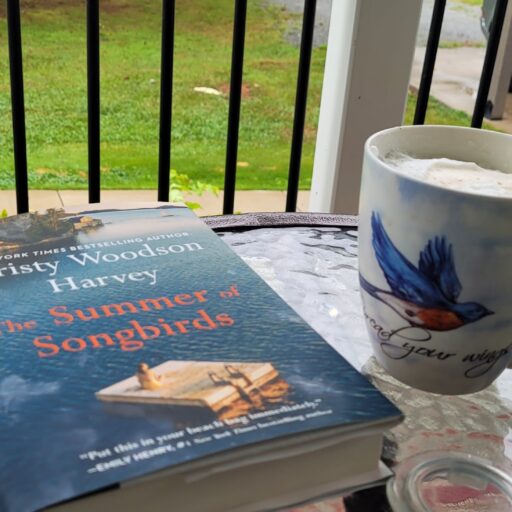
by~ Mary Stewart Spearman
I have been following Kristy Woodson Harvey’s career since she first started publishing. I learned of her first book, on the Friends and Fiction show that Harvey, Mary Alice Monroe, Patti Callahan Henry, Mary Kay Andrews and Kristen Harmel started during COVID. I really enjoyed the weekly book talks, and the insights I gained into becoming an author, something I always wanted to do. The thing that appeals most to me about these ladies and their books is that most of the settings are places that I am familiar with and love to visit.
This week, I read Kristy Woodson Harvey’s newest novel, the Summer of Songbirds. Harvey’s work really made me think about the structure, craft and purpose of writing more in depth. In her interviews on the show, she talks about how fast she writes once she has the story idea. When I read her books, they don’t feel rushed or put together fast, and they are all unique in their own way. Her Peachtree Bluff Series was a work of fiction set in a fictional seaside village. After the Peachtree Bluff series she published a book called the Wedding Veil that I fell in love with. In the Wedding Veil, Harvey sets the story at Biltmore House and focuses on Cornelia Vanderbilt as the main character. I loved the way this story wet my appetite to learn more about the main character, Cornelia Vanderbilt, and sent me off in search of books about that era. I found Denise Kiernan’s The Last Castle to be a great resource to learn more about the Vanderbilts.
This leads me to Kristy Woodson Harvey’s latest work. The Summer of Songbirds which debuted at number 13 on the New York Times Bestseller’s list in July! I was lucky enough to go to a book signing at the Anderson County Library and hear her talk about her book, and the inspiration for it. Once I started reading it, it didn’t take long before I was hooked. This is the first real page turner I’ve read in a while. While this story is fiction, there are themes that are relatable to real life, and Harvey writes about difficult subjects in a healing way. Her prose is to the point, and not overly descriptive, which at times can be refreshing. She uses just the right amount of imagery and action to keep the story moving.
The subject of addiction is fully explored in this work. Addiction affects too many families and in those families, the children are the ones that really suffer the most. Harvey shows us just how addiction can be multigenerational. Breaking the cycle of addition is something the main character deals with. Although this is a work of fiction, I find that the way she has told this story was inspiring. A quick check of statistics from the DEA will show the crisis our country is facing regarding drug overdoses and death. By focusing on this topic in the novel, Harvey is keeping this important issue front and center. Like the main character’s mother, most drug overdoses are people under the age of 50, who did not know what they were taking.
Harvey masterfully weaves the hard theme of overcoming addiction with friendship, staying true to yourself, and most importantly forgiveness. In this story about three best friends who come together and stay together through life’s ups and downs, the reader is shown many sides and points of view of how addiction affects the addict, the enabler, and the person who tries to help and becomes too close or connected. The story made me wonder, can someone really save a person from their addictions or must they finally decide to save themselves?
The characters that drive this story are all well rounded. By using alternating chapters and points of view, the reader feels what the characters are feeling.I feel like everyone who reads the book will be able to identify with at least one character, because they are all unique. Even the character of June, who is the older aunt, is complex and enduring. Although June isn’t the main character, she goes through many changes in the course of her life in this story.

The Summer of Songbirds is an excellent way to end your summer, surrounded by a lake, friends and the love of story. As good writing does, it will make you ponder deeper themes and realities especially in the post COVID era where many are dealing with the effects of addiction. Several times in the novel the author uses the phrase “Fair winds and following seas!” and explains that it means the “hope of moving forward, the promise of good to come.” I found this especially enduring because after COVID, I think that is what we all need, hope and a good future! I will be reading all of her books in the future, because I think Kristy Woodson Harvey might be one of the best writers of our time. With each of her books, the meaning gets a little deeper, and to me that is just good writing!
Check out my review of fellow Friends and Fiction Author Patti Callahan Henry:
Links: https://amzn.to/3DNJL2i






